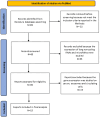HCV-related hepatocellular carcinoma: gene signatures associated with TERT promoter mutations and sex
- PMID: 40495193
- PMCID: PMC12153190
- DOI: 10.1186/s12967-025-06560-w
HCV-related hepatocellular carcinoma: gene signatures associated with TERT promoter mutations and sex
Abstract
Background: Hepatocellular carcinoma (HCC) is a rapidly progressing disease, frequently caused by hepatitis C virus (HCV) infection and a higher prevalence in males than females. Over 60% of HCCs harbour frequent activating mutations in the telomerase reverse transcriptase promoter (TERTp). However, the relationship between TERTp status, sex, and expression of specific genes remains poorly understood.
Methods: We conducted a literature search to identify genes that were significantly upregulated in HCV-related HCC, compared to the respective peri-tumour tissues, in at least two independent studies. We identified 90 genes and validated their expression in 59 matched HCV-related HCC and peri-tumour tissues using a custom multiplex array qPCR. HCV-related HCC patients were stratified by TERTp mutations and sex. Statistical analysis was performed to identify relationships between different variables.
Results: Overall, validation analysis confirmed the upregulation of 39 out of 90 genes. Expression levels of 24 genes differed significantly between HCV-related HCC with mutant and wild type TERTp. The expression of FASTK and FLVCR1 genes correlated with TNM and tumour size (p < 0.05). High expression of NUCKS1 was associated with mortality, particularly in male patients. Overall, the expression of 57 genes was sex-linked, with 26 and 48 genes significantly overexpressed in males and in females, respectively, some of which were also associated with mutant TERTp status.
Conclusions: We identified unique molecular signatures in TERTp mutant HCC associated with the activation of specific genes. Such results suggest that TERTp mutant HCC might represent a distinct clinical entity. Furthermore, the up-regulation of several genes in HCV-related HCC is sex-linked. These results are crucial for understanding the mechanisms underlying TERTp mutations in tumour progression and sex-related HCC risk and for developing more effective diagnostic and prognostic biomarkers.
Keywords: TERT; Biomarker; Female; Gene signatures; HCV; Male; Sex.
© 2025. The Author(s).
Conflict of interest statement
Declarations. Ethics approval and consent to participate: The study is in accordance with the principles of the Declaration of Helsinki, and it was approved by the Institutional Scientific Board and by the Ethical Committee of the Istituto Nazionale Tumori “Fondazione G. Pascale” (Approval number: 51/21 oss). Patients provided written informed consent to participate in the study. Consent for publication: Not applicable. Competing interests: The authors declare that they have no competing interests.
Figures





References
-
- Sung H, Ferlay J, Siegel RL, Laversanne M, Soerjomataram I, Jemal A, et al. Global cancer statistics 2020: GLOBOCAN estimates of incidence and mortality worldwide for 36 cancers in 185 countries. CA Cancer J Clin. 2021;71:209–49. - PubMed
-
- Llovet JM, Kelley RK, Villanueva A, Singal AG, Pikarsky E, Roayaie S, et al. Hepatocellular carcinoma. Nat Rev Dis Primers Nat Res. 2021;7:6. - PubMed
-
- Gao TM, Bai DS, Qian JJ, Zhang C, Jin SJ, Jiang GQ. The growth rate of hepatocellular carcinoma is different with different TNM stages at diagnosis. Hepatobiliary Pancreat Dis Int. 2021;20:330–6. - PubMed
MeSH terms
Substances
Grants and funding
LinkOut - more resources
Full Text Sources
Medical

